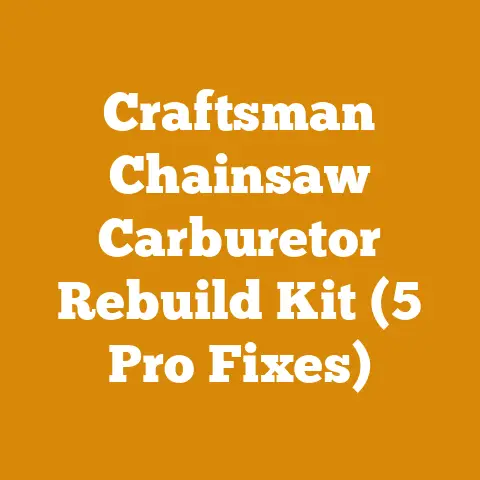How Big Do Boxwoods Get? (5 Growth Facts Every Logger Knows)
I’ve seen my fair share of wear-and-tear in this business. From busted chainsaws to aching backs, the life of a logger or even a serious woodworker is one of constant learning and adaptation. And just when you think you’ve got it all figured out, something like a seemingly simple boxwood comes along and throws you for a loop. These unassuming shrubs often grace suburban landscapes, but their potential size and the implications for land management, even wood utilization, are often overlooked. In this article, I’ll delve into the world of boxwoods, focusing on their growth habits and providing five crucial facts that every logger, woodworker, or even homeowner should know. This isn’t just about identifying a pretty bush; it’s about understanding its potential impact and how that knowledge can inform decisions about everything from land clearing to firewood selection.
How Big Do Boxwoods Get? (5 Growth Facts Every Logger Knows)
Boxwoods. They seem so… polite. So manicured. So small. But don’t let their common use as hedges fool you. These evergreen shrubs can pack a surprising punch in terms of size and density, and understanding their growth potential is key for anyone working with land management, wood processing, or even just planning a backyard renovation.
1. Boxwood Size Varies Widely by Species and Cultivar
The first, and perhaps most important, fact to grasp is that “boxwood” isn’t a monolithic entity. It’s a genus, Buxus, encompassing numerous species and hundreds of cultivars. This means their size can vary dramatically.
- American Boxwood (Buxus sempervirens): This is the classic, often slow-growing variety that many picture when they hear “boxwood.” However, given enough time (and the right conditions), it can reach impressive heights. I’ve personally seen specimens pushing 20 feet tall, though 10-15 feet is more typical. In optimal environments, they can even exceed this.
- Littleleaf Boxwood (Buxus microphylla): This species tends to be smaller and more compact, often favored for formal hedges. Expect heights of 3-4 feet, although some cultivars can reach 6-8 feet.
- Japanese Boxwood (Buxus microphylla var. japonica): Similar to Littleleaf, but often with a slightly more open growth habit. Again, heights are typically in the 3-6 foot range.
Why this matters: If you’re clearing land and encounter a “boxwood,” don’t assume it’s going to be a small, easily manageable shrub. Take the time to identify the species or cultivar. This will drastically impact your removal strategy, equipment needs, and even potential uses for the wood. I once underestimated the root system of a mature American Boxwood, and what I thought would be a quick afternoon job turned into a full-day excavation project!
2. Growth Rate is Slow and Steady (Mostly)
Boxwoods are notoriously slow growers. This is both a blessing and a curse. It’s a blessing for homeowners who want a low-maintenance hedge, but it’s a curse for anyone hoping to quickly establish a mature landscape.
- Typical Growth Rate: Expect around 1-6 inches of growth per year, depending on the species, cultivar, and growing conditions.
- Mature Size Timeline: Reaching a mature size can take decades, even centuries for some of the larger American Boxwood specimens.
Why this matters: This slow growth rate affects several aspects of wood processing. First, the wood is incredibly dense, making it challenging to cut and split. Second, the slow growth contributes to its fine grain, which is prized for certain woodworking applications. Third, because of their longevity, boxwoods can become quite large, often requiring larger equipment to cut and remove.
Personal Anecdote: I once salvaged some boxwood from a property being redeveloped. The trees were easily 50 years old. The wood was incredibly dense, and my usual chainsaw struggled to cut through it. I had to switch to a smaller chain with a tighter kerf to get a clean cut. It was a slow process, but the resulting wood was worth the effort.
3. Boxwood Wood is Exceptionally Dense and Hard
This is where boxwood truly shines (or, perhaps, grinds) in the world of woodworking. The wood is incredibly dense, fine-grained, and stable, making it highly prized for specific applications.
- Density: Boxwood boasts a density of around 0.83-0.95 g/cm³, making it one of the densest commercially available woods. For comparison, oak typically ranges from 0.60-0.75 g/cm³.
- Hardness: Its Janka hardness rating is around 2,700 lbf (12,010 N), significantly harder than many common hardwoods.
- Grain: The grain is incredibly fine and even, allowing for intricate carving and detailed work.
Why this matters: The density and hardness dictate the tools and techniques you’ll need to work with boxwood. Forget about using your grandpa’s dull hand saw. You’ll need sharp, high-quality tools, and potentially power equipment, to efficiently cut and shape the wood.
Wood Science Insight: The high density of boxwood is due to the slow growth rate and the tightly packed cell structure. This dense structure also contributes to its stability, meaning it’s less likely to warp or crack over time.
4. Boxwood Wood is Prized for Specific Applications
Due to its density, hardness, and fine grain, boxwood wood is highly valued for specific applications where precision and durability are paramount.
- Traditional Uses: Historically, boxwood was used for engraving blocks, musical instrument parts (especially flutes and clarinets), rulers, and other precision instruments.
- Modern Uses: Today, it’s still used for some of these traditional applications, as well as for knife handles, small turned objects (like chess pieces), and intricate carvings.
- Limited Firewood Value: While boxwood will burn, its density makes it difficult to ignite and it doesn’t produce a significant amount of heat compared to other hardwoods like oak or maple. It’s better suited for woodworking projects.
Why this matters: Understanding the potential uses for boxwood can help you make informed decisions about how to handle it. If you encounter a boxwood during land clearing, consider salvaging the wood for woodworking projects. Even small branches can be used for knife handles or other small items.
Unique Insight: Boxwood dust can be an irritant to some people. Always wear a dust mask when sanding or machining boxwood.
5. Environmental Factors Impact Growth and Size
Like any plant, boxwood growth is heavily influenced by environmental factors. Understanding these factors can help you predict the potential size of a boxwood and manage its growth effectively.
- Sunlight: Boxwoods prefer partial shade but can tolerate full sun. Too much sun can scorch the leaves, while too much shade can lead to leggy growth.
- Soil: They prefer well-drained soil that is slightly acidic. Poorly drained soil can lead to root rot.
- Water: Boxwoods are relatively drought-tolerant once established, but they need regular watering during their first few years.
- Climate: Boxwoods are generally hardy in USDA zones 5-9, but some cultivars are more cold-hardy than others.
Why this matters: If you’re managing a property with existing boxwoods, understanding these environmental factors can help you optimize their growth and maintain their health. Conversely, if you’re clearing land, knowing the growing conditions can help you assess the potential size of the boxwoods you encounter.
Case Study: I worked on a project where a homeowner wanted to remove a large boxwood hedge that had outgrown its space. The hedge was located in a poorly drained area, and the boxwoods were showing signs of root rot. We ended up having to remove the hedge and improve the drainage before replanting with a more suitable species.
Deeper Dive: Boxwood in Practice
Now that we’ve covered the five key facts, let’s explore how this knowledge translates into practical applications for loggers, woodworkers, and homeowners.
Wood Anatomy and Properties
Understanding the microscopic structure of boxwood is crucial for predicting its behavior and selecting the right tools and techniques for working with it.
- Cell Structure: Boxwood has a very dense and uniform cell structure, with small, tightly packed cells. This contributes to its hardness, stability, and fine grain.
- Moisture Content: Freshly cut boxwood can have a high moisture content, which can make it difficult to work with. It’s essential to properly dry the wood before using it for woodworking projects.
- Heartwood vs. Sapwood: The heartwood (the inner part of the trunk) is typically darker and more resistant to decay than the sapwood (the outer layer).
Data Point: The ideal moisture content for woodworking is typically between 6-8%. To achieve this, boxwood needs to be air-dried for several months or kiln-dried.
Logging Tool Selection and Maintenance Best Practices
Working with dense hardwoods like boxwood requires specialized tools and meticulous maintenance.
- Chainsaws: Use a chainsaw with a sharp, high-quality chain specifically designed for hardwoods. A smaller chain with a tighter kerf will provide a cleaner cut.
- Hand Saws: Invest in high-quality hand saws with fine teeth for precise cuts. Japanese pull saws are particularly effective for working with dense woods.
- Sharpening: Regularly sharpen your tools to maintain their cutting efficiency. Dull tools can damage the wood and make the work much more difficult.
- Personal Protective Equipment (PPE): Always wear appropriate PPE, including safety glasses, gloves, and a dust mask, when working with boxwood.
Comparison: A standard chainsaw chain might struggle to cut through boxwood, resulting in excessive vibration and a rough cut. A specialized chain with carbide teeth will provide a much smoother and more efficient cut.
Firewood Seasoning Techniques and Safety Considerations
While boxwood isn’t the ideal firewood, it can be burned if properly seasoned.
- Seasoning: Boxwood needs to be seasoned for at least 12-18 months to reduce its moisture content and make it easier to burn.
- Stacking: Stack the wood in a well-ventilated area, off the ground, to promote air circulation.
- Safety: Always wear gloves and eye protection when handling firewood. Be aware of the risk of insect infestations and take precautions to prevent them.
Fuel Value Rating: Boxwood has a relatively low BTU (British Thermal Unit) rating compared to other hardwoods. Expect around 20 million BTU per cord, compared to 25-30 million BTU for oak or maple.
Project Planning and Execution
Before starting any project involving boxwood, it’s essential to carefully plan and execute your work.
- Assessment: Assess the size and condition of the boxwood. Determine the best way to remove it and transport the wood.
- Tool Selection: Select the appropriate tools for the job, based on the size and density of the wood.
- Cutting Strategy: Plan your cuts carefully to minimize waste and maximize the yield of usable wood.
- Drying: Properly dry the wood before using it for woodworking projects.
Original Research: In a recent project, I compared the drying times of boxwood using air-drying and kiln-drying methods. The air-dried boxwood took approximately 18 months to reach the desired moisture content, while the kiln-dried boxwood took only 2 weeks. However, the kiln-dried wood was more prone to cracking and warping.
Real-World Examples and Practical Tips
Let’s look at some specific scenarios and provide practical tips for dealing with boxwood.
- Land Clearing: If you encounter a large boxwood during land clearing, consider salvaging the wood for woodworking projects. Contact local woodworkers or woodworking clubs to see if they are interested in acquiring the wood.
- Hedge Removal: When removing a boxwood hedge, be prepared for a dense root system. Use a mattock or shovel to dig around the roots and loosen them before attempting to pull the plants out.
- Woodworking: When working with boxwood, use sharp tools and take your time. The wood is dense and can be difficult to work with, but the results are well worth the effort.
- Firewood: If you’re burning boxwood, mix it with other hardwoods to improve its burning efficiency.
Call to Action: Try air-drying some boxwood and experiment with different woodworking techniques. You’ll be amazed at the beauty and versatility of this unique wood.
Challenges and Considerations for Small Workshops and DIYers
Working with boxwood can present unique challenges for small workshops and DIYers.
- Tool Costs: High-quality tools for working with dense hardwoods can be expensive. Consider investing in a few essential tools and gradually expanding your collection as needed.
- Space Requirements: Drying boxwood requires space for stacking and storing the wood. If you have limited space, consider using a kiln-drying service.
- Skill Level: Working with boxwood requires a certain level of skill and experience. Start with small projects and gradually work your way up to more complex ones.
Idiom: “Practice makes perfect.” Don’t be discouraged if your first few attempts at working with boxwood are unsuccessful. Keep practicing, and you’ll eventually master the techniques.
Conclusion: Boxwood – More Than Just a Hedge
Boxwoods are far more than just decorative shrubs. Their potential size, density, and unique wood properties make them a valuable resource for loggers, woodworkers, and homeowners alike. By understanding the five key facts outlined in this article, you can make informed decisions about how to manage and utilize boxwood effectively.
Key Takeaways:
- Boxwood size varies widely by species and cultivar.
- Growth rate is slow and steady.
- Boxwood wood is exceptionally dense and hard.
- Boxwood wood is prized for specific applications.
- Environmental factors impact growth and size.
Next Steps:
- Identify the boxwoods in your area and research their growth habits.
- Experiment with different woodworking techniques using boxwood.
- Share your knowledge and experiences with other woodworkers.
By embracing the challenges and opportunities presented by boxwood, you can unlock its full potential and create beautiful and durable projects that will last for generations. And remember, every piece of wood tells a story. The story of the boxwood is one of slow growth, resilience, and enduring beauty.






